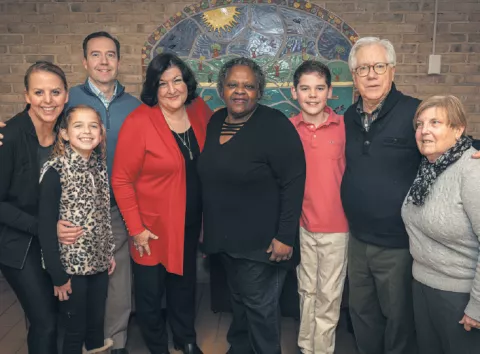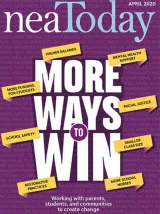In September of 1977, Jimmy Carter was president of the United States and a gallon of regular gas cost $0.62. The top song on the charts was “Best of My Love” by The Emotions, and the first episode of the long-running, hit TV show Love Boat aired on ABC. It was also the start of a new school year and a new job for Nila Brown, who has worked as a school secretary in Anne Arundel County, Maryland, for 42 years.
“I was so excited to become part of the faculty of the very school I just graduated from,” says Brown. “I felt such a great sense of pride.”
And that sense of pride has continued to fuel her decades-long career in education. Brown says she feels pride in her students; pride in being an education support professional (ESP) and an integral part of the school staff; and pride in working with a talented group of educators, dedicated parents, and a close-knit community that cares about its children.
“But what I take the most pride in is my ability to help,” Brown says.
The role of the school secretary, says Brown, is to support the entire school family, including teachers, bus drivers, custodians, principals, students, families, and community members.
“The school secretary makes it all work,” she says. “We make everything run. We are at the core of it all.”
Strength in numbers
The work of Brown and all ESPs is critically important, and this year NEA is celebrating the 40th anniversary of ESPs becoming part of the union.
“Education support professionals often are the first in the building and the last to leave,” says NEA President Lily Eskelsen García, who started her career as a school cafeteria worker. “They promote student achievement, ensure student safety, and contribute to the establishment and promotion of a positive instruc-tional environment every day.”
Advocating for great public schools means advocating with and for everyone who works in our schools. Over the last four decades, ESPs have made NEA stronger, raising their voices in communities across the country.

It’s all about the students
Brown started her career at Arundel High School in Gambrills, Md., but left in 1989 to become the secretary at Crofton Woods Elementary School in Crofton, Md., where she has worked ever since.
She’s seen a lot of principals come and go over the years, and “they have all depended on me, on my memory, and on knowing what is important to the families,” she says. “And always...what’s most important is that we do an excellent job educating their children.”
So Brown stays on top of the area’s best tutors and community enrichment programs. She also keeps an eye on what’s going on with families. She knows about all the mom groups, who walks home with whom, and who is in what friendship group.
“I watch what’s going on, I observe and I learn, and I use that knowledge to help the families,” she says. “They all know I’m looking out for the best for their children.”
And their children’s children. With a career spanning more than 40 years, she’s seen the kids she served in high school become the parents of the kids she then assisted in elementary school. And then those kids became the parents of another generation of children she saw getting off the bus. “The pattern keeps repeating, and I am blessed to know all of these wonderful families,” she says.
‘Kindness always comes back’
The parents clearly return Brown’s affection. Several years ago she was seriously injured in a car accident. She was rushed to shock trauma in Baltimore, where the lead surgeon was a former parent from Crofton Woods. He instantly remembered Brown and the kindness she had shown his son when he attended the school.
“He told his staff , ‘You get everything Mrs. Brown needs, and you take excellent care of her,’” she recalls. “When I got better, he came to visit me. It showed me I was appreciated and how kindness always comes back to you. It takes my breath away just thinking about it.”
Quick Facts About ESP History
Forty years ago, in 1980, our union became a stronger and more powerful voice for students by adding education support professionals to our ranks. NEA’s strength is in its diversity of education professions, and every educator must have a seat at the table to create the best public schools for all students. Four decades later, ESPs continue to enrich our students’ lives, and their work forms the foundation of a solid education.
How we’ve grown
The official number of ESP members in 1980 was 15,183. Today, there are 465,078 ESP members across the country.
Pioneering Peggys
The first ESPs to serve on the NEA Executive Committee were both named Peggy: Peggy McDanal, a senior accountant with the Birmingham, Ala., City Board of Education and state president of the Alabama Education Support Personnel Organization, and Peggy Brown, a secretary with the Bay City, Mich., school system and president of the Michigan Educational Support Personnel Association. Both joined the NEA Board of Directors in 1981.
More firsts
- The first National ESP Conference was held in 1986 in Washington, D.C.
- The first ESP Day was celebrated in 1987.
- The first ESP of the Year Award was presented in 1992.
Last but not least!
The RISE Award Program legislation was signed into law on April 12, 2019, as part of the Recognizing Achievement in Classifi ed School Employees Act (H.R. 276). The award acknowledges the outstanding contributions of education support professionals and classifi ed school employees to the nation’s public schools and the students they serve. Check out the ESP 40th anniversary website at NEA.org/ESP40.


